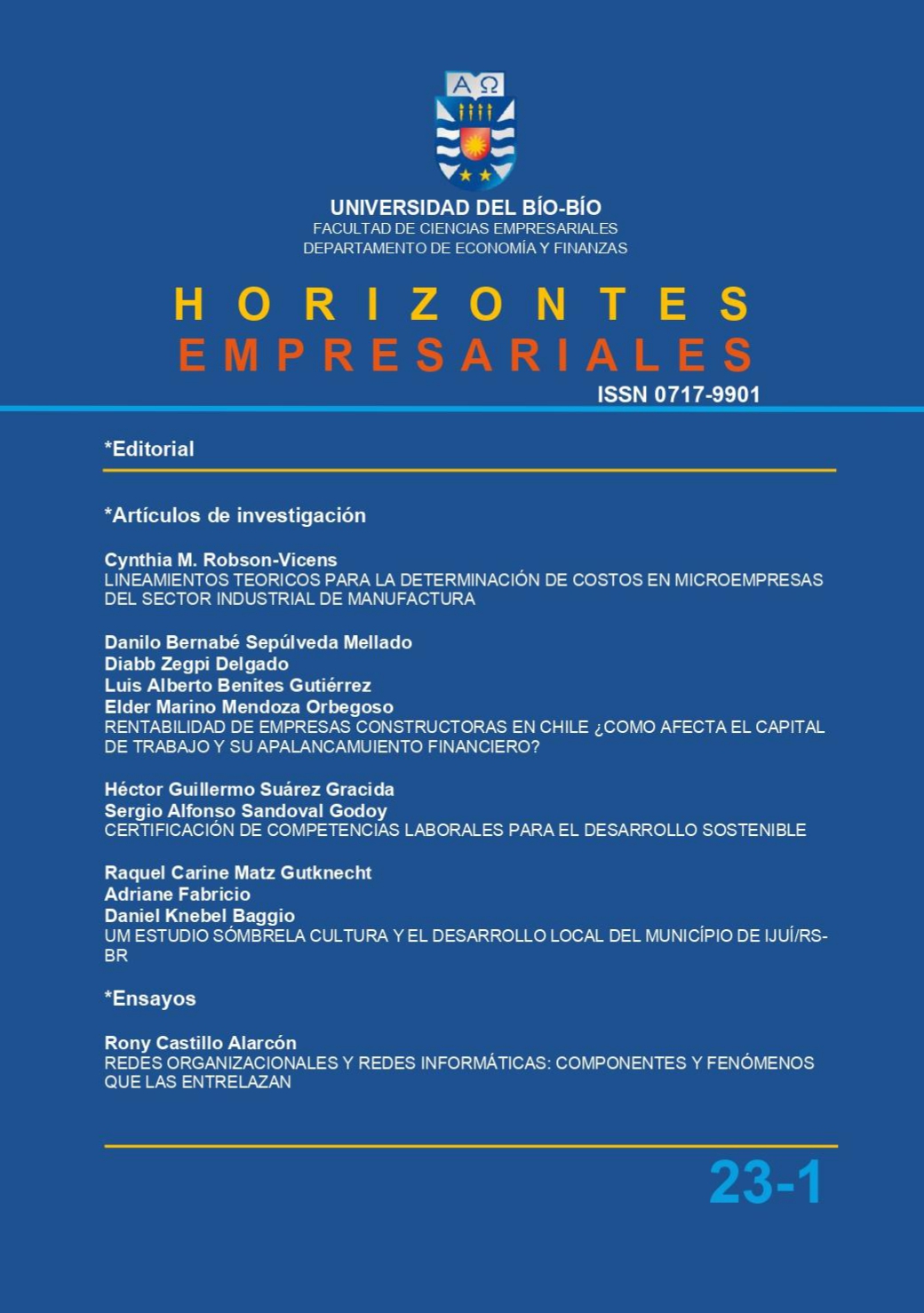Rentabilidad de empresas constructoras en Chile ¿Cómo afecta el capital de trabajo y su apalancamiento financiero?
DOI:
https://doi.org/10.22320/hem.v23i1.6621Palabras clave:
Capital de Trabajo, Rentabilidad, Margen Bruto, Empresas ConstructorasResumen
El presente trabajo de investigación se centró en modelar el desempeño financiero de empresas constructoras chilenas mediante regresiones lineales de efectos fijos y mixtos, utilizando el margen bruto trimestral como indicador de rentabilidad. Entre los modelos evaluados, se determinó que el modelo de efectos mixtos con efectos aleatorios por empresa mostró el mejor ajuste al conjunto de datos, con un coeficiente de determinación estimado (R2) de 0,92, siendo significativos variables como el CT, el CT cuadrático y la tasa de endeudamiento a corto plazo. La combinación de efectos del CT cuadrático y no cuadrático indicó que el impacto positivo del CT en el margen se hace evidente a partir de una tasa del 42% sobre los activos totales.
Citas
Abor, J. and Quartey, P. (2010), “Issues in SME development in Ghana and South Africa”, International Research Journal of Finance and Economics, Vol. 39, pp. 218-228.
Alipour, M. (2011), “Working capital management and corporate profitability: evidence from Iran”, World Applied Sciences Journal, Vol. 12 No. 7, pp. 1093-1099.
Arinaitwe, S. K. (2006). Factors constraining the growth and survival of small scale businesses. A developing countries analysis. Journal of American Academy of Business, 8(2), 167-178.
Baños-Caballero, S., García-Teruel, P. J., & Martínez-Solano, P. (2012). How does working capital management affect the profitability of Spanish SMEs?. Small business economics, 39(2), 517-529.
Ben-Caleb, E., Olubukunola, U., & Uwuigbe, U. (2013). Liquidity management and profitability of manufacturing companies in Nigeria. IOSR Journal of Business and Management, 9(1), 13-21.
Berisha-Namani, M. (2009). The role of information technology in small and medium sized enterprises in Kosova. In Fulbright academy conference (Vol. 3, No. 9, pp. 1-8).
Blinder, A. S., & Maccini, L. J. (1991). Taking stock: a critical assessment of recent research on inventories. Journal of Economic perspectives, 5(1), 73-96.
Box, G. E., & Cox, D. R. (1964). An analysis of transformations. Journal of the Royal Statistical Society: Series B (Methodological), 26(2), 211-243.
Brennan, M. J., Maksimovics, V., & Zechner, J. (1988). Vendor financing. The journal of finance, 43(5), 1127-1141.
Deloof, M. (2003). Does working capital management affect profitability of Belgian firms?. Journal of business finance & Accounting, 30(3‐4), 573-588.
Deloof, M., & Jegers, M. (1996). Trade credit, product quality, and intragroup trade: some European evidence. Financial management, 33-43.
Ding, S., Guariglia, A., & Knight, J. (2013). Investment and financing constraints in China: does working capital management make a difference?. Journal of Banking & Finance, 37(5), 1490-1507.
Eilers, P. H., & Marx, B. D. (2010). Splines, knots, and penalties. Wiley Interdisciplinary Reviews: Computational Statistics, 2(6), 637-653.
Enqvist, J., Graham, M., & Nikkinen, J. (2014). The impact of working capital management on firm profitability in different business cycles: Evidence from Finland. Research in International Business and finance, 32, 36- 49.
Fayyad, U. M., Piatetsky-Shapiro, G., & Smyth, P. (1996). Knowledge Discovery and Data
Mining: Towards a Unifying Framework. In KDD (Vol. 96, pp. 82-88).
Fayyad, U., Piatetsky-Shapiro, G., & Smyth, P. (1996). From data mining to knowledge discovery in databases. AI magazine, 17(3), 37-37.
Frawley, W.J., Piatetsky-Shapiro, G., & Matheus, C.J. (1992). Knowledge Discovery in Databases: An Overview. AI Mag., 13, 57-70.
Galecki, A., & Burzykowski, T. (2013). Linear mixed-effects model. In Linear mixed-effects models using R (pp. 245-273). Springer, New York, NY.
García‐Teruel, P. J., & Martínez‐Solano, P. (2007). Effects of working capital management on SME profitability. International Journal of managerial finance.
Gockel, A. F., & Akoena, S. K. (2002). Financial Intermediation for the Poor: Credit Demand by Micro Small and Medium Scale Enterprises in Ghana: a Further Assignment for Financial Sector Policy?. ILO.
Gujarati, D. N., & Porter, D. (2009). Basic Econometrics Mc Graw-Hill International Edition.
Hayajneh, O. S., & Yassine, F. L. A. (2011). The impact of working capital efficiency on profitability–an empirical analysis on Jordanian manufacturing firms. International Research Journal of Finance and Economics, 66(2011), 67-69.
Karaduman, H. A., Akbas, H. E., Caliskan, A. O., & Durer, S. (2011). The relationship between working capital management and profitability: evidence from an emerging market. International Research Journal of Finance and Economics, 62(6), 61-67.
Lazaridis, I., & Tryfonidis, D. (2006). Relationship between working capital management and profitability of listed companies in the Athens stock exchange. Journal of financial management and analysis, 19(1).
Long, M. S., Malitz, I. B., & Ravid, S. A. (1993). Trade credit, quality guarantees, and product marketability. Financial management, 117-127.
Mathuva, D. (2015). The Influence of working capital management components on corporate profitability.
McDonald, J. H. (2009). Handbook of biological statistics (Vol. 2, pp. 6-59). Baltimore, MD: sparky house publishing.
Nazir, M. S., & Afza, T. (2009). Impact of Aggressive Working Capital Management Policy on Firms' Profitability. IUP Journal of Applied Finance, 15(8).
Nobanee, H., & Al Hajjar, M. (2009). A note on working capital management and corporate profitability of Japanese firms. Available at SSRN 1433243.
Okpara, J. O., & Wynn, P. (2007). Determinants of small business growth constraints in a sub-Saharan African economy. SAM advanced management journal, 72(2), 24.
Owolabi, S. A., & Obida, S. S. (2012). Liquidity management and corporate profitability: Case study of selected manufacturing companies listed on the Nigerian stock exchange. Business Management Dynamics, 2(2), 10-25.
Padachi, K. (2006). Trends in working capital management and its impact on firms’ performance: an analysis of Mauritian small manufacturing firms. International Review of business research papers, 2(2), 45-58.
Pais, M. A., & Gama, P. M. (2015). Working capital management and SMEs profitability: Portuguese evidence. International journal of managerial finance.
Pansiri, J., & Temtime, Z. T. (2008). Assessing managerial skills in SMEs for capacity building. Journal of management development.
Petersen, M. A., & Rajan, R. G. (1997). Trade credit: theories and evidence. The review of financial studies, 10(3), 661-691.
Priya, K., & Nimalathasan, B. (2013). Liquidity management and profitability: A case study of listed manufacturing companies in Sri Lanka. International Journal of Technological Exploration and Learning, 2(4), 161-165.
Raheman, A., & Nasr, M. (2007). Working capital management and profitability– case of Pakistani firms. International review of business research papers, 3(1), 279-300.
Raheman, A., Afza, T., Qayyum, A., & Bodla, M. A. (2010). Working capital management and corporate performance of manufacturing sector in Pakistan. International Research Journal of Finance and Economics, 47(1), 156-169.
Ramachandran, A., & Janakiraman, M. (2009). The relationship between working capital management efficiency and EBIT. Managing Global Transitions: International Research Journal, 7(1).
Saleh, A. S., & Ndubisi, N. O. (2006). An evaluation of SME development in Malaysia. International review of business research papers, 2(1), 1-14.
Shipley, D., Egan, C., & Edgett, S. (1991). Meeting source selection criteria: direct versus distributor channels. Industrial Marketing Management, 20(4), 297-303.
Small Business Research Centre. (1992). The State of British Enterprise: Growth, Innovation and Competitive Advantage in Small and Medium Sized Firms.
Stephen, M., & Elvis, K. (2011). Influence of working capital management on firms profitability: a case of SMEs in Kenya. International Business Management, 5(5), 279-286.
Svensson, K. (1997). Trade credits in Europe today: credit cultures, payment morality and legal systems. Unpublished manuscript (Lund university).
Swierczek, F. W., & Ha, T. T. (2003). Entrepreneurial orientation, uncertainty avoidance and firm performance: an analysis of Thai and Vietnamese SMEs. The International Journal of Entrepreneurship and Innovation, 4(1), 46-58.
Tauringana, V., & Afrifa, G. A. (2013). The relative importance of working capital management and its components to SMEs' profitability. Journal of Small Business and Enterprise Development.
Ukaegbu, B. (2014). The significance of working capital management in determining firm profitability: Evidence from developing economies in Africa. Research in International Business and Finance, 31, 1-16.
Van Buuren, S. (2018). Flexible imputation of missing data. CRC press.
Vásquez, F. J., & Larre, H. P. (2020). Determinantes del capital de trabajo y ciclo de conversión de efectivo en empresas chilenas. CAPIC REVIEW, 18, 1-15.
Weinraub, H. J., & Visscher, S. (1998). Industry practice relating to aggressive conservative working capital policies. Journal of Financial and Strategic Decision, 11(2), 11-18.
Wickham, H., & Grolemund, G. (2016). R for data science: import, tidy, transform, visualize, and model data. " O'Reilly Media, Inc.".
Wilner, B. S. (2000). The exploitation of relationships in financial distress: The case of trade credit. The journal of finance, 55(1), 153-178.




